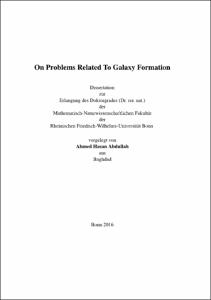On Problems Related To Galaxy Formation

On Problems Related To Galaxy Formation

| dc.contributor.advisor | Kroupa, Pavel | |
| dc.contributor.author | Abdullah, Ahmed Hasan | |
| dc.date.accessioned | 2020-04-22T01:10:47Z | |
| dc.date.available | 2020-04-22T01:10:47Z | |
| dc.date.issued | 17.05.2016 | |
| dc.identifier.uri | https://hdl.handle.net/20.500.11811/6751 | |
| dc.description.abstract | The main idea of the underlying PhD study is to trace the history of the assembly of galaxies and of their subsequent evolution. We approach this issue in two ways: 1) by studying galaxy spin and 2) by studying the oldest stellar population in a given galaxy (i.e. globular clusters). In the first part of this work, we investigated the relation between the galaxy spin and filaments. The relative orientation of galaxies with respect to their large-scale environment can provide crucial evidence for the formation and evolution of galaxies that follow the various scenarios proposed for the origin of galaxies. To perform our study, we made use of a sample of 1843 spiral galaxies at a redshift z≈ 0.0055 taken from the HYPERLEDA (Hyper-linked Extragalactic Databases and Archives). The ultimate goal for the first part was to calculate the angle θ between the projected spin vector of a spiral galaxy and the projected host filament (long strings of galaxies). The galaxy spin vector is derived from the position angle (PA) of the long axis of a galaxy image. The filaments are represented by the best-fit straight lines using linear regression and various statistical methods to test the fit quality. We found no significant statistical evidence for an alignment of galaxy spin vectors with respect to their hosting filaments. The results are in agreement with hierarchical galaxy formation theory which predicts random directions of galaxy spin vectors. In the second part of this PhD study, we investigate the properties of globular clusters and of the hosting galaxy. Globular clusters (GC) are important objects for tracing the early evolution of a galaxy. In this thesis, we study the relation between the properties of globular cluster systems -as quantified by the GC specific frequency (SN )- and the properties of their host galaxies. We support the explanation for the relation between SN and galaxy mass through tidal erosion. In order to understand the origin of the relation between the GC specific frequency (SN ) and host galaxy mass, we devise a theoretical model for the specific frequency (SN,th ). GC erosion is considered to be an important aspect for shaping this relation, since observations show that galaxies with low baryonic densities have a higher SN, while high density galaxies have a smaller number of GCs. We construct a model depending on the minimum star cluster mass (Mecl,min ), the slope of the power-law embedded cluster mass function (β), and the relation between the star formation rate (SFR) and the maximum star cluster mass (Mecl,max ). We find agreement between the primordial value of the specific frequency (SNi ) and our model for β between 1.5 and 2.5 with Mecl,min < 10^4 M_sun . We also test the relation between the SFR and Mecl,max at higher SFR than previously known. | en |
| dc.language.iso | eng | |
| dc.rights | In Copyright | |
| dc.rights.uri | http://rightsstatements.org/vocab/InC/1.0/ | |
| dc.subject.ddc | 520 Astronomie, Kartografie | |
| dc.title | On Problems Related To Galaxy Formation | |
| dc.type | Dissertation oder Habilitation | |
| dc.publisher.name | Universitäts- und Landesbibliothek Bonn | |
| dc.publisher.location | Bonn | |
| dc.rights.accessRights | openAccess | |
| dc.identifier.urn | https://nbn-resolving.org/urn:nbn:de:hbz:5n-43340 | |
| ulbbn.pubtype | Erstveröffentlichung | |
| ulbbnediss.affiliation.name | Rheinische Friedrich-Wilhelms-Universität Bonn | |
| ulbbnediss.affiliation.location | Bonn | |
| ulbbnediss.thesis.level | Dissertation | |
| ulbbnediss.dissID | 4334 | |
| ulbbnediss.date.accepted | 11.04.2016 | |
| ulbbnediss.institute | Mathematisch-Naturwissenschaftliche Fakultät : Fachgruppe Physik/Astronomie / Argelander-Institut für Astronomie (AIfA) | |
| ulbbnediss.fakultaet | Mathematisch-Naturwissenschaftliche Fakultät | |
| dc.contributor.coReferee | Massi, Maria |
Files in this item
This item appears in the following Collection(s)
-
E-Dissertationen (4164)




